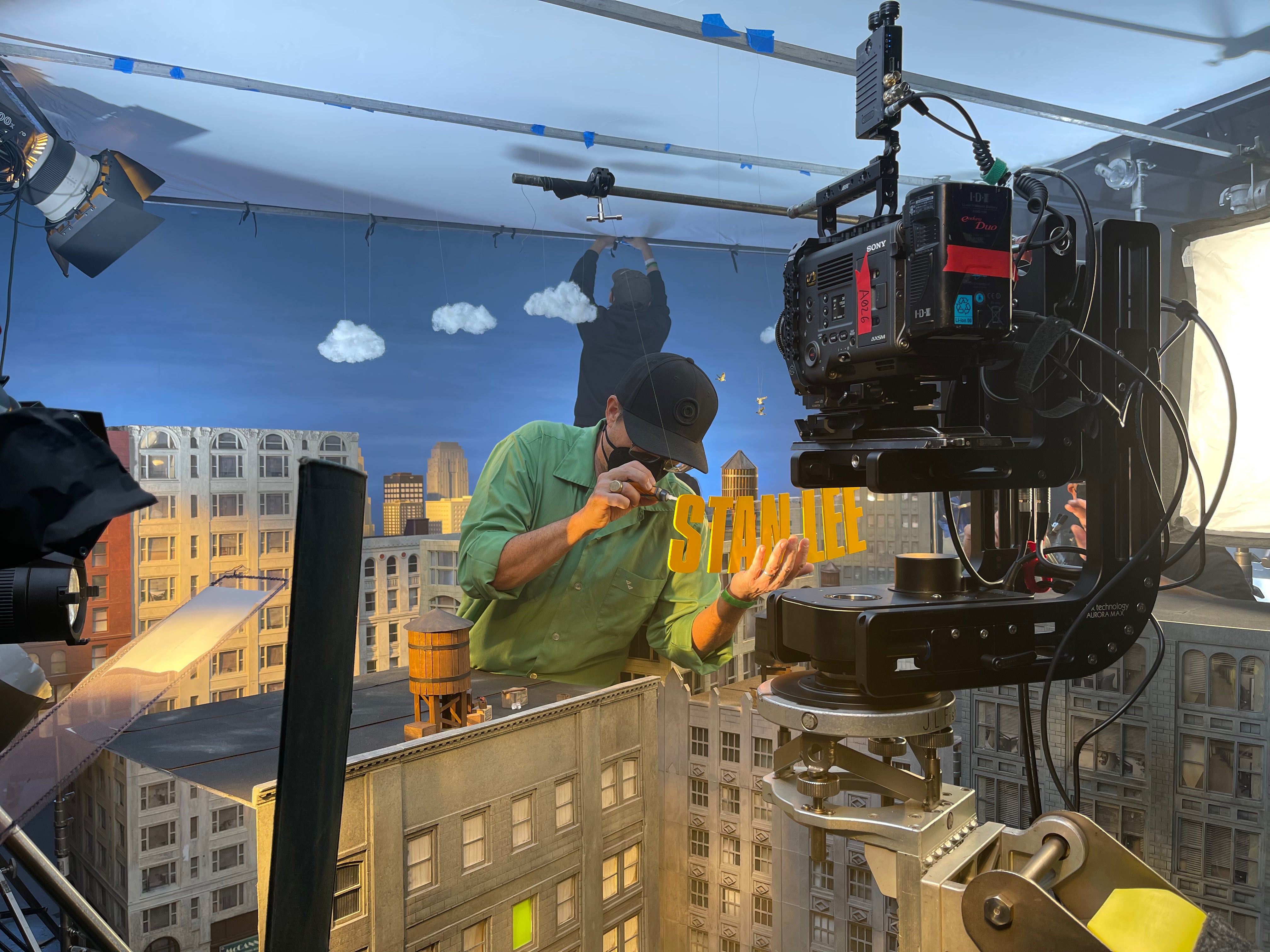
08-24-2023 - Case Study
Shot on VENICE: How DP Ernesto Lomeli Captured the Elaborate Miniature World of Beloved Comic Creator in ‘Stan Lee’
By: Oakley Anderson-Moore
To pull off the story of the creator of the most successful pop-culture franchise in the world, the team behind Stan Lee knew they couldn’t just rely on archival photographs. They needed to bring Stan to life in a bigger way – by going very, very small.
Told largely through Stan Lee’s own voice and hyper-detailed, painstakingly recreated world of magical miniatures, the film needed a cinematographer who could descend into that world of tiny detail. That cinematographer was Ernesto Lomeli.
“Supper Club had brought me on in the past to do the cool new visuals but in old school techniques,” explains Lomeli. “We did the title sequence for the new show on Disney +, and lots of visuals for their other documentaries . I was the guy doing all the old school camera tricks. We were shooting things through transparencies, vellum cutouts, putting big magnifying glasses over the lens, distorting CRT monitors with magents, filming with diopters on weird angles and swing tilts, and just giving texture to what would be mundane. So when the concept for Stan Lee came in, we all got very excited . Especially since they decided to do it all practically and not CG.
Ernesto Lomeli sat down with SonyCine to talk about shooting the eclectic world of Stan Lee with specialized macro and probe lenses on the Sony VENICE, turning mundane moments into cinema magic, and the responsibility to tell someone’s life story.
How Lomeli’s film career started as a teenager playing Morrissey in a homemade dark room
Ernesto Lomeli first began developing his cinematic eye when he moved to the United States from Baja California as a little kid.
“My brothers and I learned English once we moved here,” explains Lomeli. “So I grew up in the border town of San Diego, going back and forth all the time. There’s a dichotomy between the clean, sterile, navy beach town of San Diego and then the rough and tumble, full of grit and grime , culture and food of Tijuana. That's how I grew up seeing the world a little bit from both sides of the fence, which I'm very grateful for. Early on, I learned the context that everything is seen through a different perspective depending on where you are.”
Lomeli’s fascination with the role of perspective ignited in high school when he took his first photography class, where he was lucky to shoot 35mm and learn to process film.
“I remember learning the F/8 rule and it blew my mind,” reminisces Lomeli. “Luckily enough, I had an older brother, he's eight years older than me, who really liked photography. He had built a dark room in our tiny little apartment bathroom. Once I took that photography class in high school, he was like, ‘All right, little kid, you can come in.’ We would listen to Morrissey records and stuff. It's a perfect emo black and white photo vibe. I liked the technicality of it. I really liked the magic of it. I like getting lost in a dark room, it's intoxicating.”
From there, Lomeli continued to pursue photography until he took his first Intro to Cinema class at the Academy of Art in San Francisco.
“That first semester, I realized this was much cooler!” jokes Lomeli. “The pictures are moving, I get to work with people. You can tell a story with a single image, but the idea of adding movement and actors and collaborating with a group of people. I love this.”
Lomeli worked his way up from working in a rental house cleaning filters (and learning how to break and fix gear) to VFX work, AC and Operator, and then DP on anything from commercials like Kevin Hart’s Draft Kings Super Bowl Commercial to Amy Poehler’s Lucy and Desi.
And most recently, Stan Lee.
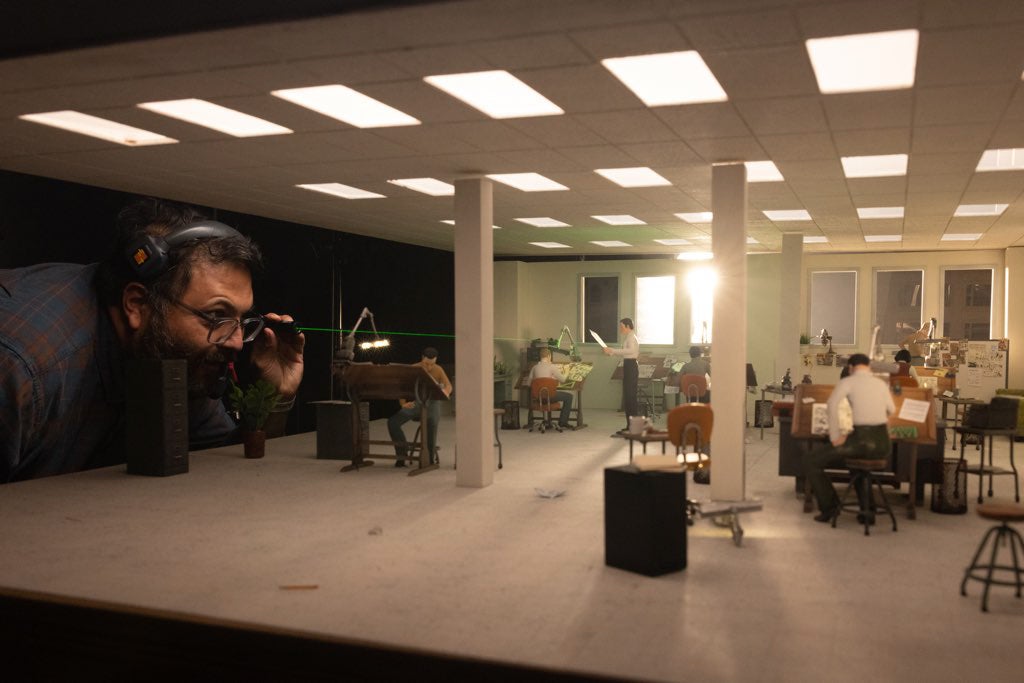
Creating a tiny pre-timed world in the style of an Edward Hopper painting
It wasn’t enough for the film to show an archival photograph of Stan Lee say, at his desk in an office writing his first comic. They decided to completely recreate the world in the picture using miniatures.
“David Gelb, our director, was brilliant to work with. He surrounded himself with very talented people,” says Lomeli. “He had this great point that you can't just do another documentary that's all archival. We had to show the origin story as best as you can. In one of the Ant Man movies, they did a CGI version of a diorama where everything is frozen and they're just moving around the battle. And that was the original reference.”
What would be the style of the world that they recreated?
“Edward Hopper, the painter, was the reference,” explains Lomeli. “That was my guiding light for everything as far as the look, the tone. Visually, that was my north star in the approach for creating this world.”
Lomeli and team then embarked on the mission to create 3D printed characters and worlds filmed with a handmade aesthetic that didn’t involve any MoCap or CG.
“I think in the end it was few weeks, with quite a bit of testing, lighting and print resolution and finishing techniques . We went through a lot of 3D printed passes and characters, and we rejected a lot. It took a while for them to get it to where we needed to get them, because we were so tight on these characters. We're doing over-the-shoulders on things that are an inch in size. We were doing lots of fun eyeballs, and these are 1/12 scale.”
In addition to having such minuscule subjects, Lomeli had to convey a handmade look while exacting precision when it came to the timing of each shot.
“The team had locked the edit and we shot to the VO, we knew where the archival would end and where it would begin. We had to fill this gap, and that gap had to be in exactly 7.8 seconds or 6 seconds or 4 seconds or 12 seconds. We were operating and timing this by hand, and so we had to make it work.”
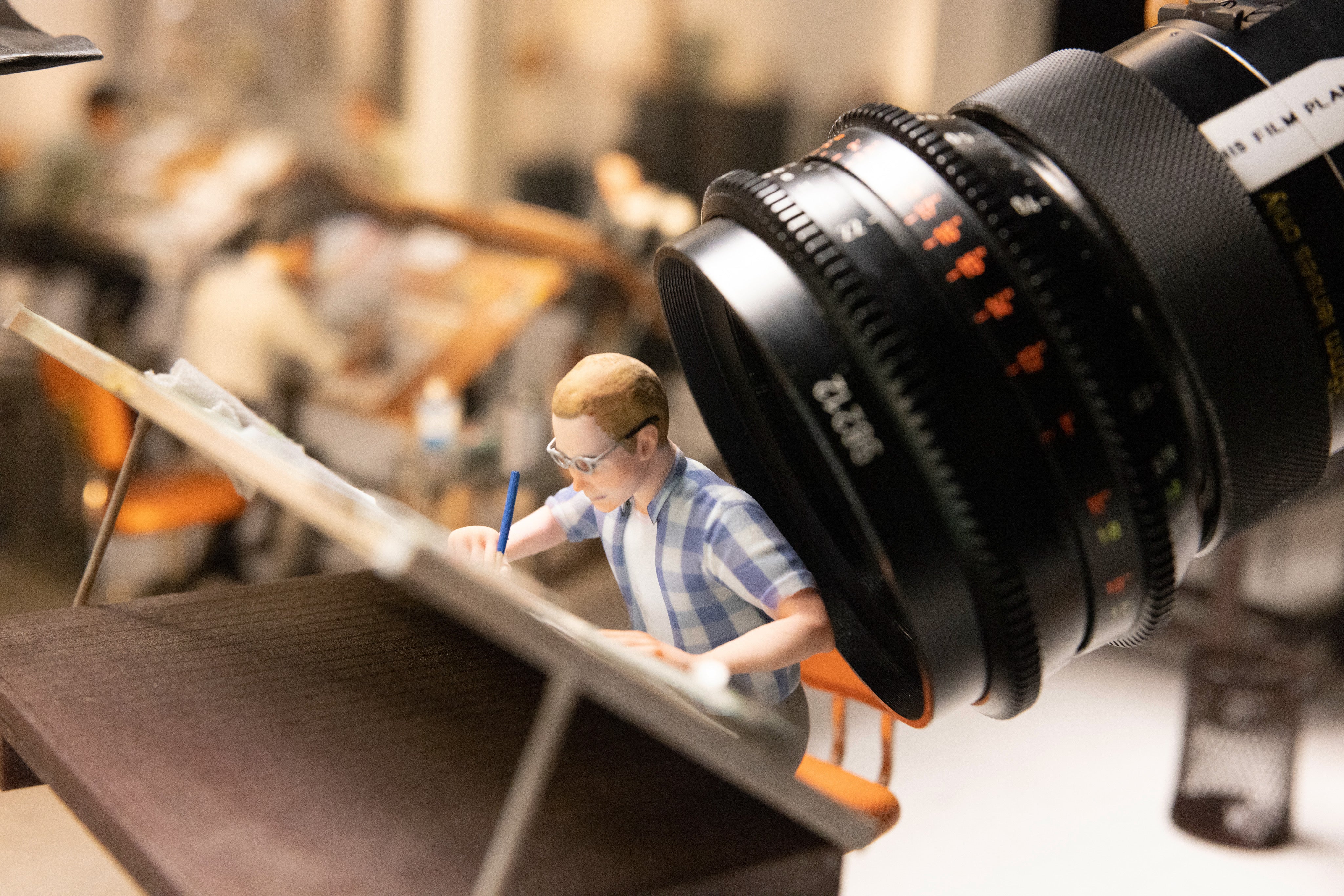
Why the Sony VENICE was the camera of choice on Lomeli’s challenging set
There were two big reasons that Lomeli needed the Sony VENICE to shoot Stan Lee.
“One, we needed to do work on probes and there's no full frame probes, so we decided to do 5K on the VENICE so that we could shoot on Super 35,” explains Lomeli.
“I'm a big believer of shooting as many pixels as possible and scaling it down gives a different sense of sharpness. It's not a critical sharpness, it's not a digital sharpness. More pixels being down res-ed just gives a different clarity.”
The film needed a 4K delivery, and other than the probe lenses, Lomeli planned to shoot exclusively on vintage Zeiss macros.
“The lenses we used were actually the lenses that shot Stewart Little,” laughs Lomeli. “We did a 16, a 24, and a 40mm macro. These old mechanical macros, they're absolutely stunning. They have a character, texture, and vibe to them. We needed something that had the ability to rotate. So we ended up going with Zeiss macros and a Skater Scope.”
Lomeli needed the skater scope to do over the shoulder while keeping the ceiling for lighting and reflections. The windows in the set had acrylic in them, because the reflections off those windows were a really important lighting technique. “We put reflections everywhere. We built sets outside of all the windows that way you always had parallax and depth ”
We needed to be flexible with the angle of our approach to be able to get the dolly track to move in, so that we can do these compound moves, so while we were in there. I needed a periscope that would sometimes let me go in at 90, 45, 30 degrees. We had to go over desks and through windows, but end up in a profile shot at times.”
The problem with all of that, and the second reason the Sony VENICE was a must, is that Periscopes eat a lot of light.
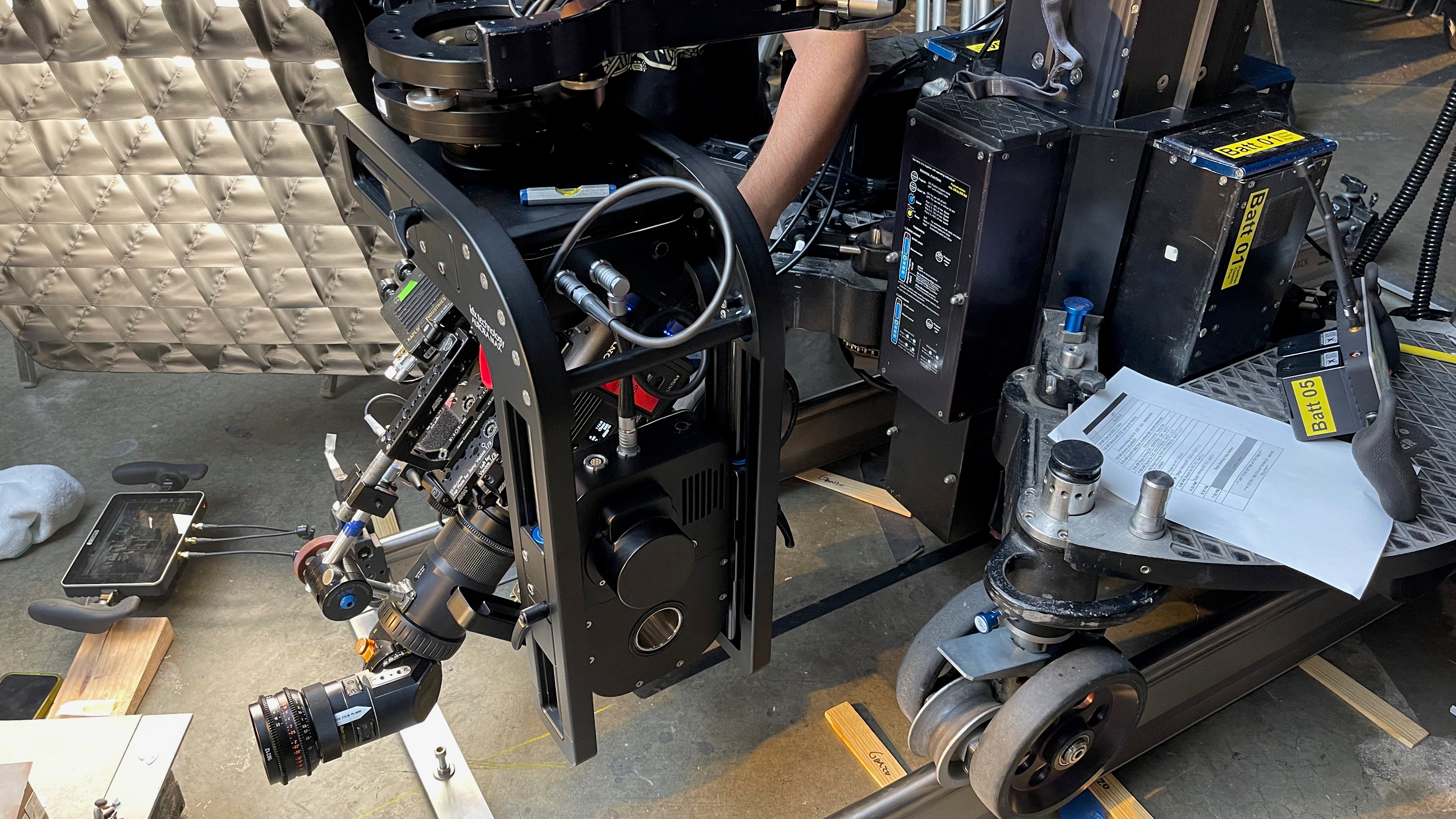
"The scope just eats it, it's a light monster. And you also don't want to shoot these jobs and build these sets and do this amazing thing and have to shoot wide open on lenses. What's the point of creating these worlds because they're not going to be sharp? We decided to go with the VENICE for the dual ISO in case I ever got into a pinch and we really needed to just close down four stops.”
If you can’t open up the lens, why not add more light? It gets even more complicated.
“I can't blast the big hard lights, because it'll melt the 3D prints. Instead, we had little practical globes. In the desk lamps, we actually had tiny little tungsten lights inside the desk lamps. And so you have to expose for them too. So we wanted the ability to switch ISO in case we just needed to close the lens down as deep as possible. And we did do it on one of the early scenes where he's sitting on the street corner and we just needed more stop. We were at minimum focus, one and a quarter inches from our subject, and we still wanted the background sharp. I like the way that the Sony sensor handled the highlights and reflections, I never worried about clipping. We shot X-OCN XT, we went big with the codec, because, why not? Why not? I think it was quite helpful in Post. The images always came out quite pristine. They have something to them. They have a vibe, they have a texture, they have soul. We were also photographing through allot of glass and haze. The whole idea was trying to impose this handcrafted soul. Handmade, you could tell people made that, it wasn't done on a computer. And that's what we wanted to portray. And I hope we helped tell that part of the story of his life, because it was quite beautiful.”
For Lomeli, as an artist, he wants his tools to enable him to feel confident about his decisions on set and for Post.
“The truth is, the camera just does what it does really well. I didn't have to think about it. I knew that whatever I could throw at it, it would handle. I knew that the codec could handle it. I knew that I had in my back pocket the ability to go higher frame rates at our resolution. I could go higher ISO if I needed it. The beautiful thing is I didn't have to think about the camera once the job started. And in the end, that's what you want your tool to do. I didn't work for the camera. The camera worked for me. I just stopped thinking about it and just concentrated on the other parts of my job – telling the story.”
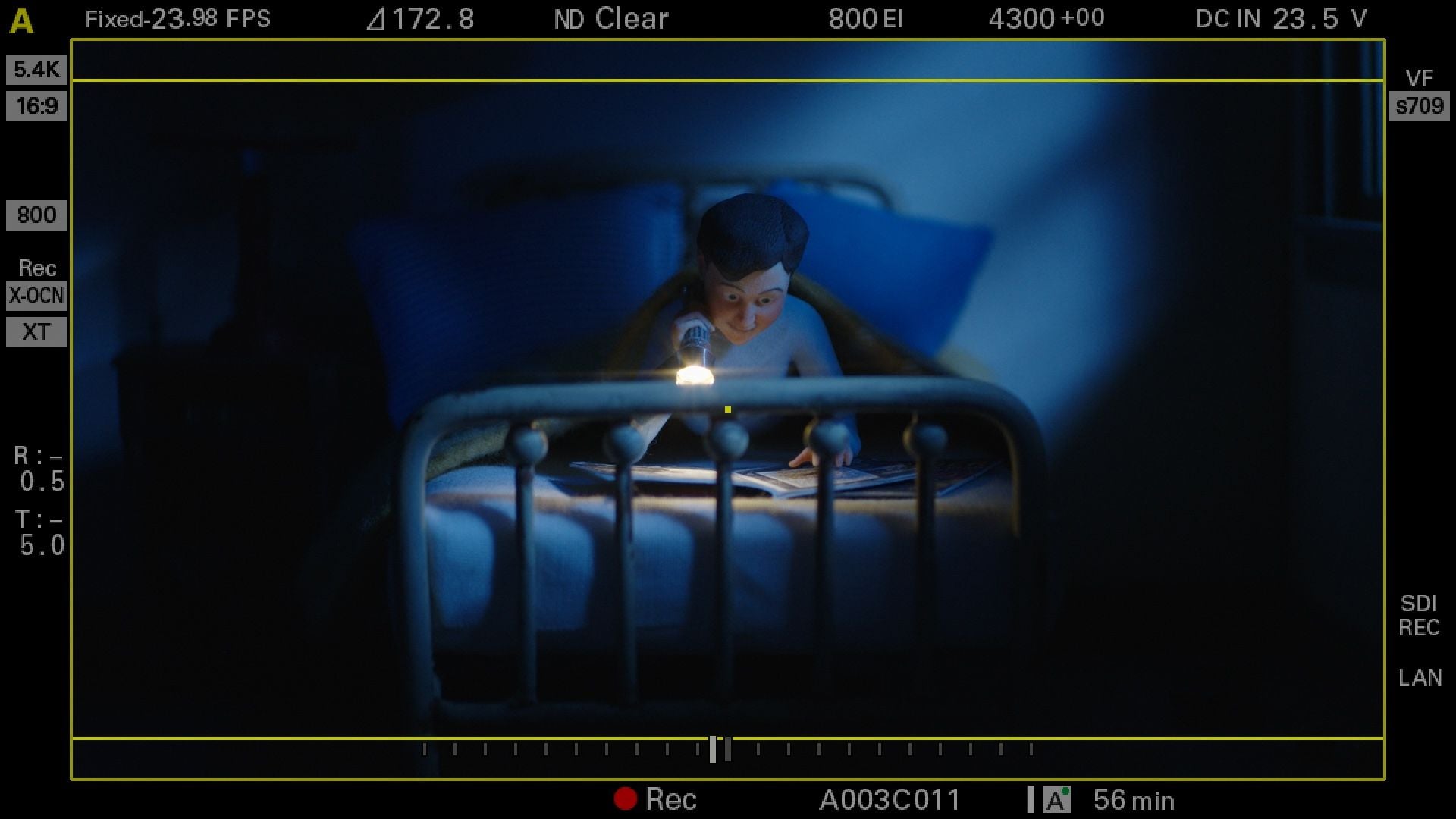
How the most challenging shot sums up the film’s entire aesthetic
If Lomeli were going to pick one sequence in the film that’s his favorite and the most challenging, it would be the opening credits.
“The title sequence – oh my God, that's a focus puller Olympics right there for you,” exclaims Lomeli. “We hung little birds off on wire, far off in the background. We put a painted backdrop of a sky, then we put little poofy clouds made out of cotton. We hung tiny pigeons, and we focused on something that is a half inch big. We dolly back, pull out, come through everything, make sure we're square on the Stan Lee logo. We frame it up, we pull focus to it, then we dive down into the city, pan left quickly, end up completely flat onto a building and we slowly push into a window to reveal a baby Stan with his parents in their apartment . That had a lot of compound moves and a lot of points. I think we had, I would say eight or 10 different focus points on that just alone. But at the same time, you don't want to pull focus. It's all one fluid motion, when it worked, it was organic, we were guiding the audience on an adventure .”
Lomeli also credits the production designer, T. Hunter McCann with helping to pull it off by working on the details with the camera department.
“Hunter was on all of that. There was a lot of research on the art department side. Everything is accurate to the specific era of the story. We just didn't shoot in an office. They had the photos of the building. We recreated the pillars, we recreated the pattern on the ceiling tiles. The building orientation on what block in New York, all of that. We were trying to be accurate to everything. We recreated all of it, because that's the way it would be back to the historical photos, we did recreations in a beautiful, magical, cinematic way.
There was no CG in the film, everything was crafted.
“In the end, it's like a Marvel movie, so you want that Marvel-iness. We're here and it's there, and it's just a stencil cutout of his name hanging over a diorama of New York. How cool is that?”
Why it can sometimes be the mundane moments that bring out the most magic
In filmmaking, sometimes we think that the more extreme moments, the bigger the story. But Lomeli points out, that sometimes it can be the exact opposite.
“You're recreating somebody's life, and that's a lot of responsibility,” says Lomeli. “We wanted it to have the hurt, the pain, the love, the joy, the energy, especially a lot of these were foundational moments of Stan Lee’s life where he got his bike and a sense of freedom. What does it feel like to be a small child and having your parents fight? Or staying up late reading a book in bed? Life can get really mundane and really boring and very stressful and very sad and all these things, but at the same time, it can be quite beautiful. It doesn't need to be something so special to make it beautiful. Sometimes the most beautiful parts of life are the simple moments, and I wanted to make those simple moments really feel magical.
In the end it's really easy to put somebody kissing on a sunset in a beautiful location and have it spark emotion. But it's another thing to just somehow show a kid getting a bicycle and it being life-transformative. So it's different and it's hard. And you want those challenges as a cinematographer, as a filmmaker, and as a person, you always want to be pushed. David, our director, really pushed us.”
In the end, the project was also about capturing Stan Lee’s role in our culture. For everyone on the project, it was incredibly important for everyone to get it right.
“Stan Lee is a contemporary to us, because he was still alive in our lifetime. But for the next generation of people, the story is of somebody that didn’t exist to them in their world. And so we created an archive, a time capsule for people to have. He created this universe where a lot of people have been able to escape to. He was really a pioneer for women, for multi representation in general. We look back on it now and it seems so simple Imagine being a kind in 1961, you have a female superhero, not just a secretary. And she was smart and witty, more than all the guys. That had never happened before. This sense of representation doesn't happen overnight. It takes a long time to get to it. And this was the beginning. So it's important. in the end, I'm really proud of what we created.”




